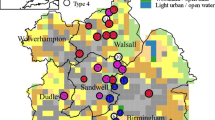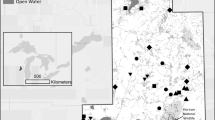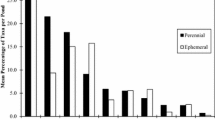Abstract
On-farm water storages (locally known as farm dams or farm ponds) are an important part of many agricultural landscapes, as they provide a reliable source of water for irrigation and stock. Although these waterbodies are artificially constructed and morphologically simple, there is increasing interest in their potential role as habitat for native flora and fauna. In this article, we present results from a case study which examined the habitat characteristics (such as water physical and chemical parameters, benthic metabolism, and macrophyte cover) and the macrophyte and macroinvertebrate biodiversity of eight farm ponds on four properties in the Stanley Catchment, Southeast Queensland, Australia. Each landowner was interviewed to allow a comparison of the management of the ponds with measured habitat and biodiversity characteristics, and to understand landowners’ motivations in making farm pond management decisions.
The physical and chemical water characteristics of the study ponds were comparable to the limited number of Australian farm ponds described in published literature. Littoral zones supported forty-five macroinvertebrate families, with most belonging to the orders Hemiptera, Coleoptera, Odonata, and Diptera. Invertebrate community composition was strongly influenced by littoral zone macrophyte structure, with significant differences between ponds with high macrophyte cover compared to those with bare littoral zones. The importance of littoral zone macrophytes was also suggested by a significant positive relationship between invertebrate taxonomic richness and macrophyte cover.
The landowners in this study demonstrated sound ecological knowledge of their farm ponds, but many had not previously acknowledged them as having high habitat value for native flora and fauna. If managed for aquatic organisms as well as reliable water sources, these artificial habitats may help to maintain regional biodiversity, particularly given the large number of farm ponds across the landscape.




Similar content being viewed by others
References
Allen AP, Whittier TR, Kaufmann PR, Larsen DP, O’Connor RJ, Hughes RM, Stemberger RS, Dixit SS, Brinkhurst RO, Herlihy AT, Paulsen SG (1999) Concordance of taxonomic richness patterns across multiple assemblages in lakes of the northeastern United States. Canadian Journal of Fisheries and Aquatic Sciences 56:739–747
Altieri MA (1999) The ecological role of biodiversity in agroecosystems. Agriculture Ecosystems and Environment 74:19–31
Babbie E (1990) Survey Research Methods. Wadsworth Publishing Company, California
Beedell JDC, Rehman T (1999) Explaining farmers’ conservation behaviour: Why do farmers behave the way they do? Journal of Environmental Management 57:165–176
Bentham CGM, MJ (1982) Social surveys. In: Haynes R., (ed.) Environmental Science Methods, Chapman and Hall, London
BOM (Bureau of Meterology) (2005a). Average daily sunshine hours - January to December: Brisbane, Commonwealth Bureau of Meteorology. (online) Available from: http://www.bom.gov.au/cgi-bin/climate/cgi_bin_scripts/idl_sunh_graphs/sunh_script.cgi?40214 (Accessed 27 February 2005)
BOM (Bureau of Meterology) (2005b). Climate Maps - Temperature Percentiles, Commonwealth of Australia, Bureau of Meteorology. (online) Available from: http://www.bom.gov.au/climate/map/anual_rainfall/index_tmp.shtml (Accessed 27 February 2005)
Brainwood MA, Burgin S, Maheshwari B (2004) Temporal variations in water quality of farm dams: impacts of landuse and water sources. Agricultural Water Management 70:151–175
Brock MA, Smith RGB, Jarman PJ (1999) Drain it, dam it: alteration of water regime in shallow wetlands on the New England Tableland of New South Wales, Australia. Wetlands Ecology and Management 7:37–46
Bunn SE, Arthington AH (2002) Basic principles and ecological consequences of altered flow regimes for aquatic biodiversity. Environmental Management 30:492–507
Casanova MT, Douglas-Hill A, Brock MA, Muschal M, Bales M (1997) Farm Ponds in New South Wales, Australia: relationship between macrophyte and phytoplankton abundances. Marine and Freshwater Research 48:353–360
Cummins KW, Merritt RW (2001) Application of Invertebrate Functional Groups to Wetland Ecosystem Function and Biomonitoring. In: Rader RB, Batzer DP, Wissinger SA (eds) Bioassessment and Management of North American Freshwater Wetlands, Wiley, New York
Curtis A, Nouhuys MV, Robinson W, Mackay J (2000) Exploring Landcare effectiveness using organisational theory. Australian Geographer 31:349–366
Declerck S, De Bie T, Ercken D, Hampel H, Schrijvers S, Van Wichelen J, Gillard V, Mandiki R, Losson B, Bauwens D, Keijers S, Vyverman W, Goddeeris B, De meester L, Brendonck L, Martens K (2006) Ecological characteristics of small farmland ponds: Associations with land use practices at multiple spatial scales. Biological Conservation 131:523–532
Denzin HK, Lincoln YS (2003) The Discipline and Practice of Qualitative Research. Sage Publishers, Thousand Oaks, California, London
EHMP (Ecosystem Health Monitoring Program). (2004) Ecosystem Health Monitoring Program 2002–2003 Annual Technical Report, Moreton Bay Waterways and Catchments Partnership, Brisbane
Fellows CS, Clapcott JE, Udy JW, Bunn SE, Harch BD, Smith MJ, Davies PM (2006) Benthic metabolism as an indicator of stream ecosystem health. Hydrobiologia 572:71–80
Fellows CS, Valett HM, Dahm CN (2001) Whole-stream metabolism in two montane streams: contribution of the hyporheic zone. Limnology and Oceanography 46:523–531
Frankenberg J (1998) Enhancing Farm Dams. In: Stelling F (ed) From Little Things Big Things Grow..... Revegetation Guide for the Riverina Highlands, Murray Catchment Management Committee, Albury, NSW
Garnier J, Billen G, Sanchez N, Leporcq B (2000) Ecological functioning of the Marne reservoir (upper Seine basin, France). Regulated Rivers-Research and Management 16:51–71
Goldsborough G (2001) Sampling algae in wetlands. In: Rader RB, Batzer DP, Wissinger SA (eds) Bioassessment and Management of North American Freshwater Wetlands, Wiley, New York
Greenberg AE, Clesceri LS, Eaton AD (eds). (1992) Standard methods for the examination of water and wastewater, 18th edition. American Public Health Association, American Water Works Association and Water Environment Foundation, Washington
Hadwen WL, Bunn SE (2005) Food web responses to low-level nutrient and 15N-tracer additions in the littoral zone of an oligotrophic dune lake. Limnology and Oceanography 50:1096–1105
Hanson PC, Bade DL, Carpenter SR, Kratz TK (2003) Lake metabolism: Relationships with dissolved organic carbon and phosphorus. Limnology and Oceanography 48:1112–1119
Hansson L, Bronmark C, Nilsson PA, Abjornsson K (2005) Conflicting demands on wetland ecosystem services: nutrient retention, biodiversity or both? Freshwater Biology 50:705–714
Hazell D, Cunnningham R, Lindenmayer D, Mackey B, Osborne W (2001) Use of farm dams as frog habitat in an Australian agricultural landscape: factors affecting species richness and distribution. Biological Conservation 102:155–169
Hazell D, Hero JM, Lindenmayer D, Cunningham R (2004) A comparison of constructed and natural habitat for frog conservation in an Australian agricultural landscape. Biological Conservation 119:61–71
Hecky RE, Hesslein RH (1995) Contributions of benthic algae to lake food webs as revealed by stable isotope analysis. Journal of the North American Benthological Society 14(4):631–653
Herb WR, Stefan HG (2003) Integral growth of submersed macrophytes in varying light regimes. Ecological Modelling 168:77–100
Hietala J, Vakkilainen K, Kairesalo T (2004) Community resistance and change to nutrient enrichment and fish manipulation in a vegetated lake littoral. Freshwater Biology 49:1525–1537
Ingram BA, Hawking JH, Shiel RJ (1997) Aquatic Life in Freshwater Ponds: A Guide to the Identification and Ecology of Life in Aquaculture Ponds and Farm Dams in South Eastern Australia. Co-operative Research Centre for Freshwater Ecology, Albury, NSW
Kadono Y (1998) Aquatic plants community in farm pond. In: Y. Ezaki and T. Tanaka (eds) Preservation of Waterside Environment: from viewpoint of Bio-Community. Asakura Shoten, Tokyo, Japan (in Japanese)
Lisson SN, Brennan LE, Bristow KL, Keating BA, Hughes DA (2003) DAM EA$Y - software for assessing the costs and benefits of on-farm water storage based production systems. Agricultural Systems 76:19–38
Lloyd SD, Bishop P, Reinfelds I (1998) Shoreline erosion: a cautionary note in using small farm dams to determine catchment erosion rates. Earth Surface Processes and Landforms 23:905–912
Loi JK, Malcolm DT (1998) Land Resource Assessment SEQ 2001 Report 6: Soils and Land Suitability The Kilcoy-Woodford Area, Department of Natural Resources, Brisbane
MacArthur RH, Wilson EO (1967) The Theory of Island Biogeography. Priceton University Press, Princeton
Maezono Y, Miyashita T (2004) Impact of exotic fish removal on native communities in farm ponds. Ecological Research 19:263–267
Murkin HR, Ross LCM (2000) Invertebrates in Prairie Wetlands. In: Murkin HR, Van Der Valk AG, Clark WR (eds) Prairie Wetland Ecology: The Contribution of the Marsh Ecology Research Program. Iowa State University Press, Ames, Iowa
Nichols P (1991) Social Survey Methods: A Fieldguide for Development Workers. Oxfam, Oxford
Nicolet P, Biggs J, Fox G, Hodson MJ, Reynolds C, Whitfield M, Williams P (2004) The wetland plant and macroinvertebrate assemblages of temporary ponds in England and Wales. Biological Conservation 120:265–282
Perkins RG, Underwood GJC (2002) Partial recovery of a eutrophic reservoir through managed phosphorus limitation and unmanaged macrophyte growth. Hydrobiologia 481:75–87
Platt S, Corrick A (1994) Management of shallow freshwater wetlands for wildlife. Trees and Natural Resources, September 2004; 12–18
Pyrovetsi M, Daoutopoulos G (1997) Contrasts in conservation attitudes and agricultural practices between farmers operating in wetlands and a plain in Macedonia, Greece. Environmental Conservation 24:76–82
QNRM (Queensland Natural Resources and Mines) (2003) Preliminary Assessment of Overland Flow Significance in the Moreton Region, Department of Natural Resources and Mines, Queensland Government
Rickson R, Saffigna P, Vanclay F, McTainsh G (1987) Social bases of farmers’ responses to land degradation. In: Chisholm A, Dumsday R (eds) Land Degradation: Problems and Policies, Cambridge University Press, Cambridge
Reidsma P, Tekelenburg T, van den Berg M, Alkemade R (2006) Impacts of land-use change on biodiversity: An assessment of agricultural biodiversity in the European Union. Agriculture Ecosystems and Environment 114:86–102
Robinson GGC, Gurney SE, Goldsborough LG (2000) Algae in Prairie Wetlands. In: Murkin HR, Van Der Valk AG, Clark WR (eds) Prairie Wetland Ecology. Iowa State University Press, Ames, Iowa
Robson BJ, Clay CJ (2005) Local and regional macroinvertebrate diversity in the wetlands of a cleared agricultural landscape in south-western Victoria, Australia. Aquatic Conservation: Marine and Freshwater Ecosystems 15:403–414
Scheffer M, Hosper SH, Meijer M-L, Moss B, Jeppesen E (1993) Alternative equilibria in shallow lakes. Trends in Ecology and Evolution 8:275–279
Schuman H, Presser S (1981) Questions and Answers in Attitude Surveys: Experiments on Question Form, Wording, and Context. Academic Press, New York
Smith MJ, Bunn SE, Storey AW, Harch BD, Redfern FM (2001) Process undertaken to develop and EHMP for rivers and streams in South East Queensland. In: Smith MJ, Storey AW (eds.) Design and Implementation of Baseline Monitoring (DIBM3): Developing an ecosystem health monitoring program for rivers and streams in Southeast Queensland. Centre for Catchment and In-Stream Research (CCISR), Griffith University and South East Queensland Regional Water Quality Management Stragegy (SEQRWQMS), Brisbane
Statzner B, Moss B (2004) Linking ecological function, biodiversity and habitat: a mini-review focusing on older ecological literature. Basic and Applied Ecology 5:97–106
Sudman S, Bradburn NM (1974) Response Effects in Surveys: A Review and Synthesis. Aldine Publishers, Chicago
Takasaki Y (1994) Odonata of irrigation pond. In The research group of natural irrigation pond (eds). Introduction to Natural History of Irrigation Pond. Gogo Shuppan, Tokyo, Japan (in Japanese)
Tenge AJ, De Graaff J, Hella JP (2004) Social and economical factors affecting the adoption of soil and water conservation in West Usambara Highlands, Tanzania. Land Degradation and Development 15:99–114
Timms BV (1980) Farm Dams. In: Williams WD (ed.) An Ecological Basis for Water Resource Management, Australian National University Press, Canberra
Tress B (2002) Application of Landscape Ecology. In: Bastian O, Steinhardt U (eds) Development and Perspectives of Landscape Ecology, Kluwer Academic Publishers, Dordrecht, The Netherlands
Tscharntke T, Klein AM, Kruess A, Steffan-Dewenter I, Thies C (2005) Landscape perspectives on agricultural intensification and biodiversity - ecosystem service management. Ecology Letters 8:857–874
Waterways (2002) Stanley Catchment, Healthy Waterways. (online) Available from: http://www.healthywaterways.org/PAGE120417PM5Y31FI.html (Accessed 10 August 2004)
Wetzel RG, Likens GE (1991) Limnological Analyses, 2nd edition. Springer-Verlag, New York
Williams P, Whitfield M, Biggs J, Bray S, Fox G, Nicolet P, Sear D (2003) Comparative biodiversity of rivers, streams, ditches and ponds in an agricultural landscape in Southern England. Biological Conservation 115:329–341
Zimmerman BL, Bierregaard RO (1986) Relevance of the equilibrium theory of island biogeography and species-area relations to conservation with a case from Amazonia. Journal of Biogeography 13:133–143
Acknowledgments
We are indebted to all of the landowners who allowed us access to their properties and provided additional information about the management of their farm ponds. Thanks also to the Ecosystem Health Monitoring Program (EHMP) of the Moreton Bay Waterways and Catchments Partnership for making data available to be used in this paper. We also thank Fran Sheldon for her advice in sampling techniques and data analysis; Dan Wruck for analyzing our nutrient samples; Wade Hadwen for providing helpful comments to help develop this manuscript; and the many field volunteers who helped to collect this data. This project was funded by the Griffith School of Environment and the Australian Rivers Institute, Griffith University.
Author information
Authors and Affiliations
Corresponding author
Appendix
Appendix
Rights and permissions
About this article
Cite this article
Markwell, K.A., Fellows, C.S. Habitat and Biodiversity of On-Farm Water Storages: A Case Study in Southeast Queensland, Australia. Environmental Management 41, 234–249 (2008). https://doi.org/10.1007/s00267-007-9037-7
Published:
Issue Date:
DOI: https://doi.org/10.1007/s00267-007-9037-7




